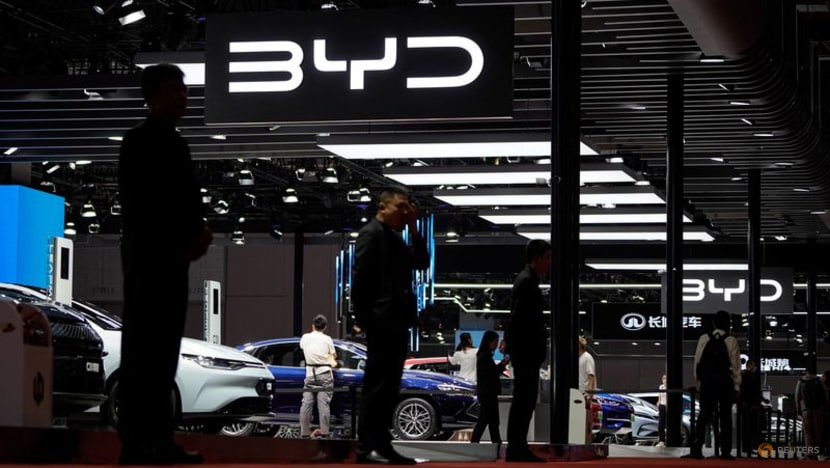Commentary: US-China tensions make it harder for Southeast Asia to go green
Between Chinese expertise in green technology and the lucrative US market, Southeast Asia is caught between a rock and a hard place when it comes to climate solutions, says S Rajaratnam School of International Studies’ Kevin Chen.


This audio is generated by an AI tool.
SINGAPORE: An often-repeated proverb is that the grass suffers when elephants fight.
For countries in Southeast Asia, addressing climate change is an existential issue due to their vulnerability to rising sea levels. But these challenges and costs are being exacerbated by US-China competition.
According to the Asian Development Bank, the region needs to invest US$210 billion per year to construct new infrastructure to address climate trends. The International Energy Agency estimates that global clean energy investments will need to reach US$4.5 trillion annually by the early 2030s to meet their climate targets.
In the aftermath of the historic COP28 deal on transitioning away from fossil fuels, many observers have raised an uncomfortable question: Who’s going to pay for this? The hundreds of millions of dollars committed during the United Nations climate conference are a good start, but still far short of the mark.
While supply chain shifts have allowed some Southeast Asian economies to attract investments and develop their own value chains, other aspects of geopolitical rivalry between the two superpowers threaten to undermine the region’s green transition.
INVESTMENTS ARE RISING, BUT SO ARE COSTS
First, the good news. By positioning themselves as neutral parties with growing middle classes and lower labour costs, Southeast Asian economies have disproportionately benefitted as companies relocate their China investments amid growing US-China tensions. The region attracted a record US$222.5 billion in foreign direct investment (FDI) in 2022 in a post-pandemic bump.
This trend continued in 2023, with the US unveiling billions of dollars in investments into Vietnam shortly after upgrading their ties to a comprehensive strategic partnership, including a US$1.6 billion chip factory by Amkor.
China, meanwhile, invested heavily in Southeast Asia’s electric vehicle (EV) sector. Carmaker BYD is building a plant in Thailand and Geely announced a US$10 billion investment to develop Malaysia’s Automotive High-Tech Valley in Perak.
If only US-China competition was all about who could invest the most into the region. Their rivalry has other serious implications.
Observers should be wary of Washington’s embrace of industrial policy, or government efforts to support strategic industries by eschewing free market policies for interventionism. Even as the Inflation Reduction Act pumps over US$369 billion into the US clean energy sector, other countries might launch their own industrial policies with an arsenal of subsidies to remain competitive.
In a worst-case scenario, FDI might be drawn away from the region and towards markets with better subsidies.
Washington’s focus on friend-shoring, or relocating supply chains to friendly countries to address security concerns, is also likely to result in higher costs and real output losses for third countries. A working paper by the European Bank for Reconstruction and Development even found that friend-shoring could cost up to 4.6 per cent of global gross domestic product.
Separately, Beijing’s willingness to weaponise its dominance of the rare earth market in bilateral disputes, as Japan experienced in 2010, poses uncomfortable questions for other countries. Rare earth elements are critical for the development of green infrastructure such as photovoltaic panels, EV engines and wind turbines.
Global demand for these minerals is expected to surge by 400 per cent to 600 per cent in the next several decades. Any shortage would have knock-on effects on the price of these fixtures, making green transitions more expensive.
POLITICAL RISKS
As US-China tensions deepen, security concerns can make it difficult for firms to do business.
Beijing recently displayed suspicion of US carmaker Ford’s agreement with Chinese battery maker CATL over fears that Ford may access sensitive battery technology. Washington, too, has been preoccupied with removing China-linked suppliers from its supply chains, even at the expense of US climate goals.
A case in point is the 2022 US Commerce Department investigation into eight solar panel companies in Southeast Asia (Malaysia, Thailand, Vietnam and Cambodia) accused of skirting US tariffs on Chinese-sourced materials.
That the US is heavily reliant on these four countries for photovoltaic panels – accounting for about 75 per cent on imports in 2021 – was not enough to defend against bipartisan determination to crack down on “unfair” Chinese trade practices.
Not only did the Commerce Department find the exporters guilty of skirting tariffs, but the US Congress voted to reinstate tariffs of up to 254 per cent on solar panels from Southeast Asia. President Joe Biden vetoed this legislative bid, but his waiver on retroactive tariffs only extends until June 2024.
In effect, Southeast Asian firms are caught between a rock and a hard place. They might be forced to choose between Chinese expertise and the lucrative US market, limiting their ability to grow and support their home country’s green transition.
NAVIGATING ROUGH WATERS, WITH HELP
The costs of a failed green transition are especially stark for Southeast Asia. One model by Deloitte predicted that the region could lose US$28 trillion over the next 50 years in losses from tourism, services and manufacturing if its carbon emissions are not addressed.
While these challenges are steep, they are not insurmountable. There is still room to leverage the competition between the two superpowers to support the region’s green transition.
The Just Energy Transition Partnerships signed with Indonesia and Vietnam, for example, are Western initiatives that respectively pledge US$20 billion and US$15 billion to decarbonise the energy mix of the two countries.
Meanwhile, even as China’s Belt and Road Initiative slows, its focus on Southeast Asia will likely remain to counter US influence. Regional governments should take the opportunity to request projects that best suit their climate needs.
Southeast Asian governments should also cast a wide net for climate partners. The recently announced Japan-led Asia Zero Emission Community, for example, included an announcement that Japan would fund US$135 billion over the next 10 years to support climate policies. There are mechanisms from Europe, such as the US$2.5 billion European Climate Foundation’s Southeast Asia Clean Energy Facility, that are aimed at catalysing public investments as well.
Even with a challenging road ahead, Southeast Asia should continue doing what it does best: Navigating a course between feuding superpowers to fuel its own development.
Kevin Chen is an Associate Research Fellow with the US Programme at the S Rajaratnam School of International Studies (RSIS), Nanyang Technological University (NTU), Singapore.
















